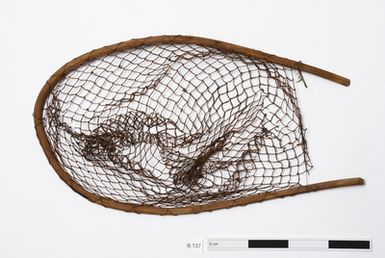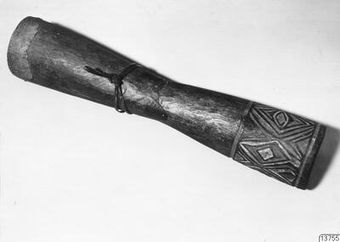Connect with Horniman Museum and Gardens
Contact this content partner to get more information about this item.
hand net
- Description:
- Woman’s Hand-Net for Fishing, Central Province, Papua New Guinea. In most coastal areas of Oceania, both men and women have traditionally occupied themselves in the business of getting protein from the sea, although usually the sexes take on different kinds of work. This ‘gendered division of labour’ (as anthropologists call it) requires different tools for taking different kinds of prey. This net of coarse rope on a wooden frame is from the southern coast of Central Province in Papua New Guinea. It is a woman’s fishing net for use in the hand, and reflects the general rule of women fishing on foot and inshore (inside and on top of the fringing reef of coral), while men tend to fish from boats outside the reef in deeper waters. Working together to guide the fish into their nets, groups of related women will often equal or exceed the catches of their men-folk. It often seems that the large, deep-sea fish that men catch are given greater cultural importance in societies where both of the sexes fish, and it is worth asking if there is a sexist bias in the way these different kinds of work are valued. Anthropologists working in this region of the Western Pacific have shown that the kind of coastal fishing that women do is much more likely to succeed at all than the deep-sea fishing of men, and that it occupies much less of the women’s time. However, the same studies have found that the times when men make successful catches at sea, the amount of meat they obtain is larger and, as a result of that, men more often share their catch with distant relatives, or trade a surplus of fish with other people for exotic goods. Both kinds of fishing are good, therefore, and complement each other very well. Wood, vegetable fibre. Early 20th Century. Collected in 1904 by the Cooke-Daniels Ethnographical Expedition, and presented to the Horniman Museum in 1906 by Dr. C. G. Seligman. Woman's hand net made from a U-shaped piece of wood with a vegetable fibre net bound over the wood.
- Format:
- image
- Collections:
- Horniman Museum and Gardens
- Content partner:
- Horniman Museum and Gardens
- Availability:
- Not specified
-
Copyright status: All rights reservedFind out more about what you are able to do with this itemThis item is all rights reserved, with means you'll have to get permission from Horniman Museum and Gardens before using it. For more information, please see our use and reuse page.More informationHorniman Museum and Gardens has this to say about the rights status of this item:
http://rightsstatements.org/vocab/InC/1.0/
What can I do with this item?Non-infringing useNZ copyright law does not prevent every use of a copyright work, and this item may be hosted by an international institute or organisation. You should consider what you can and cannot do with a copyright work.No sharingYou may not copy and/or share this item with others without further permission. This includes posting it on your blog, using it in a presentation, or any other public use.No modifyingYou are not allowed to adapt or remix this item into any other works.No commercial useYou may not use this item commercially.
Welcome and warm Pasifik greetings
The information on this site has been gathered from our content partners.
The names, terms, and labels that we present on the site may contain images or voices of deceased persons and may also reflect the bias, norms, and perspective of the period of time in which they were created. We accept that these may not be appropriate today.
If you have any concerns or questions about an item, please contact us.

